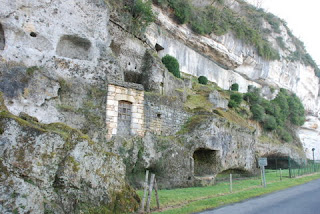



Even colder this morning with the outside temperature down to -2.7°C and the inside temperature feeling about the same until the heating took effect! This slowed us down somewhat as the desire to jump out of bed was severely diminished by the cold.
After filling with water, emptying the toilet and defrosting the windscreen, we set of for Lascaux and arrived just 10 minutes before the next guided tour. Lascaux has the best prehistoric cave paintings in France but they suffered badly from being opened to the public soon after their discovery by four teenagers in 1940. By 1963 the algae growth and calcite forming on the paintings was so bad that the decision was taken to close the caves to the public. A very ambitious project was then initiated and 20 years later a facsimile (known as Lascaux II) of the major part of the cave was opened to the public. It is a fantastic achievement, faithfully reproducing a large part of the cave structure and the paintings inside a cave just a few hundred metres down the hill from the original cave. Although we had read about the caves, we were still stunned by the sight. The walls and ceilings are covered with paintings – there are 1,963 in total with 915 representations of animals such as horses, bison, cattle, deer and a bear. Many of these are incredibly lifelike, the quality is amazing especially considering the age and the tools that the painters had. There are also a huge number of signs and other mysterious marks but only one, stylised, human being is represented. Many of the paintings are superimposed on other paintings and much works has been done to identify the different layers. The paintings all date to the same period, about 18,600 years ago, and it is thought that they may have all been completed within a few generations. The guide was very good, although understandably, the English explanations were only a fraction of the length of the French ones but this gave us plenty of time to wonder at the sights.
We then moved on to Eyzies-de-Tayac stopping off at 'Roque St. Christophe', a troglodytic settlement. Many of the caves in the area have been occupied by people through time and in the Middle Ages caves were often extended and additions built on in wood. Roque St. Christophe is such an example but we saw it in many other cases including all around the museum site at Eyzies and at the entrance to Font-de-Gaume.
Lunch was taken at Font-de-Gaume whilst we were waiting for our booked visit at 15:00. This cave is the only one with polychrome paintings that is still open to the public and visitor numbers are strictly limited to 180 per day. In the summer, booking well in advance is essential but we were extremely lucky to have the trip entirely to ourselves. Our main guide was new to the job, giving only her third tour and she must have been horrified by the fact that we were English! Her English was very poor and she hadn't had the time to learn all of the essential words associated with the trip. This meant that it was great fun but with help from a second guide (whose English wasn't very good either) we got by with lots of hand-signs, sound effects (“moooo” told us that it was a cow – we had already worked that out!) and the usual Franglais. The cave is very restricted, narrow and low in many places but high in others. As in Lascaux, some of the paintings are very high (15m in Font-de-Gaume) and had to be painted with the use of wooden scaffolding. We couldn't see those but the ones at our level were fantastic, much better than Lascaux despite being fainter because they were real and in a real setting. Once again, many animals were depicted with bison, cows, deer and horses most prominent but the sense of movement in the figures was amazing – horses galloping and jumping for instance. The biggest revelation was when the guide turned off the lights and used her torch to simulate the flames that would have been used in prehistoric times – the animals moved! The way that they had been painted with the addition of carving and the use of the natural curves in the cave walls meant that we could see animals moving as the light moved. I jokingly said that it was like an early form of cinema and perhaps they charged for entry in prehistoric times. This was taken seriously – they believe that the effect was quite deliberate and, in another cave, a number of carvings had been found of the same figure in slightly different poses, just like the stills that make up a movie. It was easy to imagine the effect that walking through this cave would have on prehistoric people that also, perhaps, had a fear or reverence for the underground. We felt very privileged to have been allowed into the cave with its hugely valuable and delicate contents. If you get the chance to visit it, do so before they decide that it is too delicate and valuable to allow entry to the public.
The camperstop was really busy (one other motorhome) and we picked our spot close to the river and prepared the evening meal.
Photos: The entrance to the original Lascaux cave, surprisingly on the hillside rather than in a cliff; Roque St. Christophe; The location of Font de Gaume; The entrance to the Font de Gaume cave with evidence of the mediaeval buildings in the cliff behind.
No comments:
Post a Comment